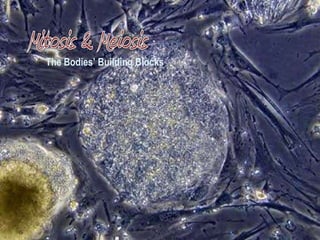
Banana phone cassie
- 1. The Bodies’ Building Blocks
- 2. Cells are the basic unit of life. Without them we wouldn’t be able to create more life or have any nourishment. We simply couldn’t exist. Each cell has a certain lifespan. Some cells, like intestinal cells, die and are replaced every day, while brain cells hardly divide. When we grow we get more cells. But where do these cells come from? And how do we grow? The mechanism used to build up bodies is called mitosis! The pictures in the background are pictures of different types of human cells. Some replace more frequently than others. (from left to right: stem cell, heart cell, skin cell, liver cell.)
- 3. Mitosis is simpler and works in repairing damage made –like cuts and bruises-, building the body, and only has one step. Meiosis, on the other hand, creates the tools needed to create new life, like eggs and sperm. It also has to go through another series of steps before it has created the necessary cells.
- 4. Mitosis is what built this cute little puppy and what fixes his paw when he cuts it. Here’s a brief summary on how it works:
- 5. Interphase is when the cell prepares for cell division by copying its DNA or just doing what a cell does on a day to day basis. This is what the cell spends most of its time doing. In prophase the chromatin coils itself and forms a chromosome, the storehouse for DNA. The centrosomes move to opposite sides of the cell and the nuclear envelope breaks down. In metaphase the chromosomes line up in the middle of the cell and the centrosomes produce spindles that attach to the chromosomes. In anaphase the spindles pull the chromosomes into chromatids and take them to separate ends of the cell. Telophase is the phase where the cell begins to split into two daughter cells. The nucleus reforms around the chromosomes. Cytokinesis is the final stage and will often begin at the same time as telophase. The cytoplasm forms and the two cells are now separated.
- 7. Meiosis is like mitosis, except a bit more complicated. It creates four cells instead of two and creates haploid cells instead of diploid. Haploid cells are cells with only a single set of chromosomes, so that when they join up with another cell (like an egg and sperm) they form a complete set. Diploid cells are cells that have the complete set of chromosomes, because they’re loners and don’t have to join with anybody.
- 8. Interphase: In this stage the chromosomes are duplicated. Prophase I: Like in a square dance, the chromosomes pair up. The formation they make is called a tetrad. While in this formation, the chromosomes exchange genetic material. This ensures genetic diversity. Metaphase I: The tetrads line up in the center of the cell and spindles attach themselves to each tetrad. Crossing Over Anaphase I: The spindles pull the pairs apart and take them to separate ends of the cell. Telophase I: The nuclear membrane, which was previously dissolved, reforms around each group of chromosomes. Cytokinesis: The cell separates and forms two new daughter cells.
- 9. Prophase II: The chromatids become visible, and the chromosomes do not replicate. Metaphase II: The chromosomes line up in the center of the cell. Anaphase II: The chromatids separate. Telophase II & Cytokinesis: The cell is split and you now have four haploid cells. As you can see meiosis II isn’t that much different from mitosis, but the results are. The four daughter cells are haploid and, when combined to another like it, form a zygote, which will eventually turn into a new life.
- 10. Mitosis makes diploid cells, meiosis makes haploid cells Mitosis is for bruises and growing, meiosis is for creating sex cells Mitosis only has to make two cells, meiosis has to make four. Without either process life could not continue There are six phases of cell division: Interphase, prophase, metaphase, anaphase, telophase and cytokinesis. Each phase is consistently in both types of cell division.
- 11. And a big thank you to my references! Works Cited Carter, Stein. “Meiosis.” iology.clc.uc.edu . N.p., 2 Nov. 2004. Web. 7 Apr. 2011. <http://biology.clc.uc.edu/courses/bio104/meiosis.htm>. “ Mitosis and Meiosis.” faculty.clintoncc.suny.edu . N.p., n.d. Web. 7 Apr. 2011. <http://faculty.clintoncc.suny.edu/faculty/michael.gregory/files/bio%20101/bio%20101%20laboratory/mitosis/mitosis.htm>. newton.dep.anl.gov . N.p., n.d. Web. 7 Apr. 2011. <http://www.newton.dep.anl.gov/askasci/bio99/bio99361.htm>.